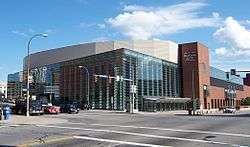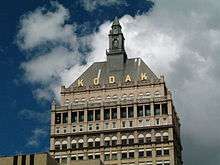Downtown Rochester
| Downtown Rochester | |
| Location of downtown Rochester. Red areas are always defined as downtown; orange areas are sometimes defined as downtown. | |
| Country | United States |
|---|---|
| State | New York |
| City | Rochester |
| Population | 6,138 (2014) |
| ZIP Codes | 14603, 14604, 14608, 14614 |
| Area code | 585 |
| Website: www | |
Downtown Rochester is the economic center of Rochester, New York, and the largest in Upstate New York,[1] employing more than 50,000 people, and housing more than 6,000.[2]
History
Rochesterville, as it was once called, was founded in present day downtown Rochester by Col. Nathaniel Rochester, Maj. Charles Carroll, and Col. William Fitzhugh, all of Hagerstown, Maryland. After the opening of the Erie Canal, which flowed through downtown Rochester until the early 20th century, the area boomed as a result of the city's flour industry. By 1834, some 20 flour mills were producing 500,000 barrels annually, the population reached 13,500 and the city area expanded to 4,000 acres (16 km2). Rochester was then re-chartered as a city, and Jonathan Child, son-in-law of Col. Rochester, was elected its first mayor.
Following the Civil War, many post-war industrial companies were founded in Rochester including Kodak, Bausch & Lomb, Western Union and Gleason Works. The city hall opened downtown in 1875.
At the turn of the century, Rochester was a thriving city. Street cars operated throughout the area and a subway was opened in 1927 on the old Erie Canal bed that ran through downtown. The subway operated for 29 years until it closed in 1956. After the subway was shut down, a series of bus routes were opened and a new auxiliary Interstate Highway was opened that would become I-490.[3]
In 1962, Midtown Plaza was constructed in downtown Rochester. Midtown was a major urban shopping mall and the first urban indoor shopping mall in the United States. Midtown Plaza brought many people downtown, but it would soon become a victim of suburbanization. In the 1980s, suburban shopping malls such as Eastview Mall in Victor and The Marketplace Mall in Henrietta opened up. McCurdy's and Forman's closed in 1994. Their closing was quickly followed by the closing of the Midtown branch of Wegmans Food Markets. Before long the mall's only tenants were Peebles department store, Radio Shack, Payless Shoes, some downscale clothing stores, a dollar store, two jewelry stores, a gift shop and a US post office. The mall finally closed in 2007 and the land was redeveloped into a mix of residential and office space.[4]
Downtown Rochester is currently entering a renaissance. For the first time in over 60 years, businesses are moving back into center city instead of fleeing it. Some of these businesses include ESL in 2010, Nothnagle in 2011, and Windstream Communications in 2013.
Community Profile

Downtown Rochester is showcased by several skyscrapers including the 450 ft (140 m) Xerox Tower, creating an urban setting. In the early 2000s, the City of Rochester built new condos and other residential buildings in Downtown with huge success. Older buildings are being converted into lofts. The current vacancy rate downtown is less than the 5% average in most downtowns.
The downtown area is also home to many shops, bars, restaurants, parks and a few designated parking areas. Manhattan Square Park, located downtown, changes seasonally. During the winter months, the park attracts ice skaters to its kidney-shaped rink while in the summer the rink becomes a pool equipped with three fountains. Live music is played at the park during the summer. There is also a boat tour on the Genesee River. The Mary Jemison Boat Tour provides a boat tour of the Genesee River overlooking the Rochester skyline.[5]
Economy
As the hub of the metropolitan economy, Downtown Rochester is home to many of the region's largest employers. The corporate headquarters of ESL Federal Credit Union, Eastman Kodak, Frontier Communications, and several other companies are located in or around downtown. Xerox, while no longer officially headquartered in Rochester, has its primary offices Downtown. In addition, Chase Bank, Bank of America, Carestream, and Time Warner Cable have large branch offices located downtown.[6]
Downtown is also home to the Rochester City Government, the Rochester City School District, and the offices for Monroe County, as well as the city, county and federal courts for the region.[7]
In 2014, Hart's Local Grocers opened in the Downtown Rochester, the store is next to the Little Theatre (Rochester, New York).[8]
Transportation
Downtown Rochester acts as the hub for the Rochester-Genesee Regional Transit Service. Most of the traffic, especially from the suburban park-and-ride locations, flows through Broad Street Station and Chestnut Street Station.[9] The Rochester Amtrak Station and the Greyhound Station for the city are also found downtown.
Landmarks
The following buildings, museums and cultural institutions of note are located in Downtown Rochester.[10]
- Blue Cross Arena
- Xerox Tower
- Bausch & Lomb Place
- Chase Tower
- One HSBC Plaza
- First Federal Plaza
- Times Square Building
- Midtown Tower
- Rundel Memorial Library
- Hyatt Regency Rochester
- Strong National Museum of Play
- Kodak Tower
- The Eastman Theater and the Eastman School of Music
- Geva Theatre Center
- Rochester Contemporary Art Center
- High Falls
- Frontier Field
Districts/Neighborhoods
Downtown Rochester comprises seven primary districts.[11]
 The High Falls District
The High Falls District Bausch & Lomb Place in the Central Business District
Bausch & Lomb Place in the Central Business District A portion of the Downtown Skyline
A portion of the Downtown Skyline Blue Cross Arena
Blue Cross Arena Eastman Theater
Eastman Theater Kodak Tower
Kodak Tower
The Central Business District, also called Washington Square or Main, is the location of several major businesses including Xerox, Chase Bank, Bausch and Lomb, Washington Square Park, the Riverside Convention Center, and the Rundel Memorial Library. The three tallest buildings in Rochester are found here.
The High Falls District is centered around High Falls, the site of many of the old Rochester factories and warehouses. The area was the site of a largely unsuccessful city-sponsored project to create an entertainment district in the northern part of Downtown, though several bars and restaurants are still in place. During the summer and on major holidays, the falls themselves are lit up in a high-tech lights show. Many of the old industrial buildings in the neighborhood have been renovated extensively and converted into condominiums and loft apartments. Frontier Field and the corporate headquarters of Eastman Kodak are located in the High Falls District. The 360/365 Film Festival is the successor to the High Falls Film Festival.[12]
Grove Place is a small residential neighborhood in north-east downtown. Most of the structures are historical apartment buildings, row houses and Victorian townhomes. Most of the residents in Grove place are students and professional musicians associated with the nearby Eastman School of Music[13]
St. Paul Quarter is another residential district also in north-east downtown, located next to Grove Place. Initially, St. Paul was composed mainly of sweatshops, factories and warehouses built in the 19th century that were later renovated and converted into apartments. Recent history saw the area become a home for many young professionals and students at the Eastman School, then one of the city's premier nightlife districts. Clubs, Bars, Restaurants and Cafes can be found throughout the St. Paul Quarter, and the neighborhood is one of several premier locations for the Rochester International Jazz Festival (one of the largest festivals of its kind in North America).[14]
The East End is the hub of the metropolitan area's dining, nightlife and music culture, named for being the terminal point of East Avenue. As the city's primary nightlife district the East End is packed with clubs, bars and high-end restaurants mainly concentrated along East Avenue and Alexander Street. The Eastman School of Music, which consistently ranks among the top three musical conservatories in the nation alongside the Juilliard School and the Bloomington School at Indiana University, is found on East Avenue alongside the school's Eastman Theater, one of the premier performing arts centers in Rochester. The other major point of interest in the district is the Strong National Museum of Play, the largest museum of its kind in the United States. Festivals include the Rochester International Jazz Festival (conducted mostly in the East End) and the East End Festival. Art and Film activity is concentrated at the Rochester Contemporary Art Center and the Little Theater, one of the oldest art-house movie theaters in the country.[15]
The Four Corners area is located on the Western shore of the Genesee River and is primarily a commercial district. The Four Corners is home to some of Rochester's finest examples of art-deco architecture, including the Powers Building and the Times Square Building. Also found in the Four Corners are the primary offices for the City of Rochester and Monroe County, Blue Cross Arena, the Monroe County Court (the Civic and Justice Center), and the iconic First Federal Plaza building.[16]
The Cascade District is found to the west of Four Corners. Previously occupied by factories and storage houses, the Cascade District is now another mixed residential/commercial area characterized by high-end apartments and condos found in renovated industrial spaces.[17]
Future Developments
It was announced on October 16, 2007 that Midtown Plaza would be knocked down to make way for the new PAETEC headquarters via eminent domain. The new headquarters were expected to be about four stories high and have a LEED-certified rooftop garden. The headquarters was expected to be finished in Q4 2012, but was pushed back with multiple delays. Work on the old Midtown began on August 1, 2010.[18] As of November 2014, the Midtown redevelopment project is still under construction. Midtown Tower has just recently begun renovation and is expected to open as a mixed use tower of apartments, condos, restaurants and stores by the end of 2015. Windstream opened a regional headquarters and Gannett is in the planning stages of constructing an adjacent office building. The City of Rochester is also accepting requests for propsals for parcel 5, a block along Main Street.
There is also a high demand for housing in Downtown Rochester. The number of permanent residents within the inner loop has recently reached an estimated 6,000 people, increasing further the demand for food and entertainment amenities. Hart's Local Grocers, the first full service grocery store to open in over 20 years began servicing downtown once again in the Summer of 2014.
See also
References
- ↑ Daneman, Matthew, "Our manufacturing roots sprout jobs", Democrat and Chronicle (March 2, 2008) (archived copy)
- ↑ http://www.rochesterdowntown.com/wp_rddc/wp-content/uploads/2013/11/MARKET-REPORT-Publisher-Version-November-2013.pdf
- ↑ Rochester Transit Corporation 1956 subway shutdown notice to passengers. ()
- ↑ http://www.cityofrochester.gov/article.aspx?id=8589944374
- ↑ "Mary Jemison Boat Tour."
- ↑ "RocDocs- Largest Rochester Area Employers (2011)". Democrat & Chronicle RocDocs. Democrat & Chronicle. Retrieved 2012-01-22.
- ↑ "RocDocs- Largest Rochester Area Employers (2011)". Democrat & Chronicle RocDocs. Democrat & Chronicle. Retrieved 2012-01-22.
- ↑ "Hart's Local Grocers offers delivery and online ordering". Democrat and Chronicle. Retrieved 25 January 2015.
- ↑ "Rochester-Genesee Regional Transit Service". Rochester-Genesee Regional Transit Service. Retrieved 2012-01-22.
- ↑ "ISCC Downtown Rochester Map" (PDF). ISCC. Retrieved 2012-01-22.
- ↑ "Rochester City Living Downtown Page". Rochester City Living. rochestercityliving.com. Retrieved 2012-01-22.
- ↑ "High Falls District Web Page". High Falls.US. HighFalls.us. Retrieved 2012-01-22.
- ↑ "Grove Place Neighborhood Web Page". groveplace.org. groveplace.org. Retrieved 1/12/22. Check date values in:
|access-date=(help) - ↑ "RDCC St. Paul Quarter Page". 1/22/12.
- ↑ "Rochester East End". Retrieved 2012-01-22.
- ↑ "RDDC Four Corners Page". Retrieved 2012-01-22.
- ↑ "RDDC Cascade District Page Page". Retrieved 2012-01-22.
- ↑ Barnhart, Rachel "Midtown demolition starts August 4th.", 13 WHAM News
Coordinates: 43°9′25″N 77°36′27″W / 43.15694°N 77.60750°W